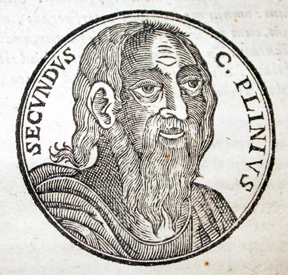
By Brian Freeman
Pliny the Elder was a Roman naturalist. He was a fellow soldier and friend of Vespasian. He dedicated his great work and writings to Titus. According to the Columbian Encyclopedia his only surviving work is an encyclopedia of natural science. The Funk and Wagnalls New World Encyclopedia states that Pliny the Elder wrote many scientific works on top of writing many historical works during his lifetime including De Laculatione Equestri, Studiosus, Dubius Sermo, and many others. Pliny the Elder’s best known work is his great encyclopedia the Historia Naturalis which is the only one of his works that has been preserved. E.W. Gudger wrote that Pliny the Elder was one of the most industrious students and one of the most educated men during the time that he lived.
Gaius Plinius Secundus also known as Pliny the Elder was born in A.D. 23. He was born in the town of Como in northern Italy. Little is known about his early life. Jerry Dennis wrote in an article in the Smithsonian that it is likely that his parents were in a high social standing and quite possibly comfortably wealthy. He was first educated in Como, Italy and later in Rome, Italy. According to Jerry Dennis, Pliny the Elder was educated in many different areas such as science, literature, philosophy, art, oratory, and theatre. Dennis also states that Pliny the Elder entered the military at the age of twenty-three and served as an officer in Germany for seven to eight years. He eventually rose in rank to commander of auxiliary cavalry regiment. Dennis goes on to say that after Pliny the Elder’s service in the military he returned to Rome, Italy to study law and pursue a career in writing.
Pliny the Elder’s career is mostly traced back to the letters that his nephew, Pliny the Younger, wrote. Pliny the Younger portrays his uncle as “a man of intense curiosity and ambition, to tireless in his research and so dedicated to a life of letters that he slept only a few hours each day, devoted virtually every waking moment to his work and in the 56 years that he lived, tallied the equivalent of several lifetimes’ worth of accomplishments”. According to Dennis, many wondered how a man like Pliny the Elder was able to compose so many books. Pliny characteristically worked twenty hours out of every twenty-four hour day. John M. Riddle states in The American Journal of Philology that “Pliny was not a renaissance man but a practical, ‘encyclopedic man’ and Roman to the core”.
Pliny the Elder’s best know work is his encyclopedia the Historia Naturalis. This encyclopedia consists of thirty-seven books on nature and art. In his encyclopedia he has 20,000 important facts that were for the Roman Emperor Titus. The Funk and Wagnalls New World Encyclopedia says that first ten books were published in A.D. 77 and the rest were published after Pliny the Elder died. The encyclopedia is concerned with many different areas such as astronomy, anthropology, zoology, botany, medicine and many others. The encyclopedia consists of many medical facts. According to D.E. Eicholz in The Classical Review, Pliny the Elder paid close attention to assure that he used proper medical language. According to Charles G. Nauert, Jr. “Pliny’s Natural History became an influential book of natural science from the moment of its publication. There is evidence for at least some knowledge of it during every medieval century”. Nauert also says that Pliny the Elder’s encyclopedia was never lost but did undergo stages of re-evaluation during the fifteenth and sixteenth centuries. According to John M. Riddle in an untitled article, Pliny the Elder is lacking in some areas in his encyclopedia. These areas include geography, diet, magic, rationality, and art. According to E.H Gudger, Pliny the Elder’s encyclopedia was not printed until 1469.
Much of Pliny the Elder’s work has been studied by reading the letters of his nephew, Pliny the Younger. Most of what is known about Pliny the Elder has been found through these letters that were wrote by Pliny the Younger. John Henderson discusses Pliny the Younger’s letters in an article called Knowing Someone Through Their Books: Pliny on Uncle Pliny. John Henderson also discusses how these books are the main source of information into Pliny the Elder’s life. Henderson says, “Pliny will for us fade eerily and unsatisfactorily away into oblivion, when his letters give out, and we have no story of his end”. Henderson is meaning that if it were not for these letters then there would be no information about Pliny the Elder’s life or how it tragically ended.
Many of Pliny the Elder’s writings have been lost. One of the most interesting writings that Pliny the Elder might have written was a journal entry that describes the eruption of Mount Vesuvius on August 24, 79. Dennis Jerry writes that Pliny the Younger wrote a letter to Tacitus describing in detail how Pliny the Elder spent his last moments before Mount Vesuvius erupted. According to Dennis Jerry, Pliny the Elder was working as though it was a normal day in a villa on the shore of the Bay of Naples. This is where he had been place in command of a navy fleet. Dennis goes on to say that according to Pliny the Younger’s letter, Pliny the Elder climbed to the top of a hill to view the cloud that was appearing over Mount Vesuvius. Pliny wanted to go for a closer look and boarded a boat and went toward the city of Stabiae which was near the base of the volcano. Pliny the Elder and his crew decided to leave Stabiae as the danger started worsening, but the waves prevented them from launching their boats so they had to wait for the wind to end. Pliny the Elder died from sulfurous gases that suddenly swept down on to the beach which probably obstructed his breathing and blocked his windpipe.
Pliny the Elder was a very influential writer. John M. Riddle wrote in The American Historical Review that classicists ignored Pliny the Elder as a writer. He also says that these classicists would judge Pliny the Elder and view him as “a mere credulous compiler”. Riddle also discussed that Renaissance scholars give Pliny the Elder credit for contributing scientific thought to writing. Many scholars will agree with Riddle when he says that Pliny the Elder’s Historia Naturalis is an, “extremely important work for what it reveals about ancient learning as well as its cultural legacy for posterity”. Pliny the Elder was also a very inspiring historian. He inspired other historian such as Tacitus. Ernst Breisach agrees and states that Tacitus’s approach in politics comes from Pliny the Elder.
Pliny the Elder’s works also had a big influence on natural history. E.W. Gudger wrote that “thus for the fourteen hundred years between Pliny’s death and the appearance of his book in print, no other work contributed so much to keep natural history alive; and as we shall see later, for the three hundred years following the appearance of the first printed edition in 1469, it was still the great authority, read, studied, and quoted by all students of natural history”. Gudger goes on to say that this encyclopedia was the foundation for all other books that would be written about natural history.
Pliny the Elder lived a very interesting life and wrote many amazing works. Pliny the Elder was very dedicated to any project he worked on and would work for numerous hours without sleeping. Although he is most famous for his encyclopedia on natural history called Historia Naturalis, he had many other great works that were not preserved. If it was not for this encyclopedia then little would be known about the lifestyles of ancient Romans. This encyclopedia still remains a valuable source of information. Pliny the Elder was a very influential historian who continues to influence historians to this day.








